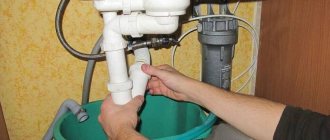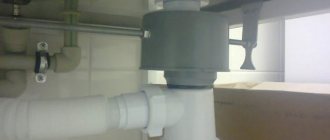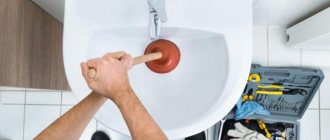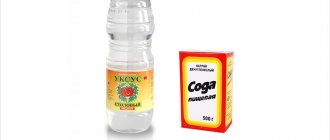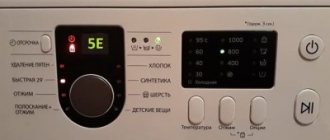Owners of apartments and private houses sometimes have to deal with such a problem as clogged pipes. The drain can become clogged either in the kitchen sink or in the bathtub or toilet in the bathroom. This situation is quite unpleasant due to the fact that the water stops draining and over time a terrible smell appears. In addition, it becomes impossible to use the plumbing and, as a result, you have to periodically run to your neighbors. What are the main causes of clogged pipes?
Causes of clogged pipes
There are several prerequisites for blockages in sewer pipes, and most of them are related to the human factor:
- Incorrect installation. If the required slope of the pipe is not observed, over time, deposits from the grease of washed dishes and cleaning products begin to be deposited inside it. This plaque can trap food particles and small debris, thereby reducing the clearance of the pipe.
- Age of pipes. In old houses, where cast iron pipes were still used as sewerage, unevenness and rust deposits form on the walls of the sewerage over time. These irregularities can trap debris and food particles, thereby narrowing the lumen of the pipes.
- Incorrect operation. The home drain is not designed to flush large debris down it. Thus, a rag accidentally forgotten in a bucket after cleaning the apartment may accidentally end up in the toilet, thereby completely clogging the drain. In addition, during the harvest period, the risk of clogging with large vegetable debris increases.
Why does blockage occur?
Before you start the fight, you need to know the enemy by sight, which means you need to figure out what causes blockages. The first, and perhaps most important, is people’s livelihoods. It is not always possible to control what and in what volumes goes into the sink, and therefore into the pipes. The most difficult in terms of clogging are:
- The longer the hair, the more reliably the pipe is clogged.
- Animal fur.
- Pieces of rags (rags).
- Paper, napkins.
- Items that should not be in pipes.
Even if precautions are taken, small particles accumulate in the drain pipe and prevent the outflow of water; the most problematic area is the water seal
There are different types of blockages, and they vary in the degree of water passage. If it does not go away at all, then it is a complete blockage, this occurs if a plug of loose debris has formed in the pipes, the same hair, wool, paper. If the water leaves, but more slowly than usual, then this is an incomplete blockage. And this is even worse, because over time, in addition to the difficulties with the outflow of water, an unpleasant odor will be added, because what is stuck in a “favorable” environment with high humidity will begin to rot and emit an odor.
Causes:
- improper operation. Do not wash pets or carpets in the bathroom;
- incorrect installation of the pipe system. If the slope is insufficient or the pipes are sagging, blockages will be common.
If your pipes are clogged, don’t rush to call a plumber, you can solve the problem yourself
Mechanical cleaning
In order to clear a blockage in a pipe mechanically, you will need the following tools:
1. Plunger. This method is good due to its simplicity and accessibility. The edges of the plunger must be lubricated with cream; even hand cream will do. Next, the tool should be firmly attached to the drain hole and begin to vigorously pump up and down. The excess and deficit of pressure created in the pipe will destroy the blockage and force it to move from a dead point.
Important! Before you start working with the plunger, you must tightly plug the overflow hole with a rag, and also, if you have a second sink drain, to avoid loss of pressure.
2. Plastic bottle. The method is applicable to clearing a clog in the toilet if there is no plunger in the house. Take a large plastic bottle, from which the bottom is cut out, while the lid remains closed. Next, the bottle, base down, is placed in the water of the drain hole, after which reciprocating movements are made similar to the method with a plunger. Fluctuating water should break up the blockage.
Important! The method is relevant if the blockage has formed in the drainage part of the toilet itself. If there is a blockage in the sewer pipe, you will need a cable.
3. Cable. When a clog has formed in the sewer pipe, a plunger will no longer help. Here you cannot do without such a tool as a special cable, which can be purchased at hardware stores. At one end there is a brush or spiral tip, at the other end there is a handle that allows you to hold the cable with one hand and scroll with the other. The operating principle of clearing a clog with a cable is that the tip with the nozzle is inserted into the sewer through an inspection hatch, a disassembled siphon, or into the toilet drain. By rotating, the cable is pushed until the head of the cable rests against the plug. Next, without stopping the rotation, you must try to destroy the plug or go through it in order to then pull it out. During operation, you should periodically pour hot water down the drain, helping to destroy the plug and flush it further into the sewer.
Important! Clearing a clog with a cable is only applicable to metal sewer pipes. It is not recommended to clean plastic pipes in this way.
4. Automatic pipe cleaning machine. For severe clogs, an automatic drain cleaner can help.
Its peculiarity is that it automatically pushes the cable into the pipe while rotating it, then, groping for the plug, destroys it and brings it out. Due to its low cost, it is advisable to buy it for professionals who provide plumbing services in their city.
Removing blockages in pipes at home using chemicals
To eliminate the problem, you can use special chemicals for blockages in pipes, for example, “Mole” and the like. Their mechanism of action is to convert solid substances that interfere with the normal operation of the system into a liquid state. This happens quickly, thanks to the alkaline compounds included in such products.
However, you should know that this cleaning method is suitable for plastic pipes, but it is better not to use it for metal. How to clear a blockage using “Mole” or another chemical at home? Cleaning with these products is carried out in the following order:
- Pour the chemical into the pipe.
- Wait for the time specified in the instructions.
- Fill the system with plenty of hot water.
Related article: New insoles with your own hands
A means to combat blockages can be in the form of:
- powder, which must be poured into the drain hole and filled with hot water;
- liquid that does not require preparation and is poured directly into the pipe;
- gel, the method of use of which is the same as for liquid products.
In most cases, even severe blockages in the sewer system can be easily removed in this way. If none of the above methods help, it is better to contact a specialist.
Chemical cleaning
If the blockage is not severe and is not associated with large debris getting into the sewer, commercial products for blockages can help. In order to clear a blockage in a pipe, you can purchase such drugs as: “Mole”, “Tiret”, “Sanfor”, “Mr. Muscle” or “Domestos”. The classic option, of course, is “Mole”; it has been known to our housewives since the times of the USSR.
Operating principle:
- A couple of buckets of hot water are poured into the sink, bathtub or toilet to allow the plaque to soften.
- The purchased cleaning agent is poured in and left for several hours.
- After the allotted time, pour a couple of buckets of cold water into the bathtub or sink, and in the case of a toilet, press the flush several times. The flow of water will wash away the remnants of the chemical with traces of the dissolved blockage.
Important! When working with household chemicals, remember that these are concentrated acidic or alkaline products. And when working with them, you must protect yourself with rubber gloves and strictly follow the manufacturer’s instructions.
Pressure cleaning
It should be noted that this device, which is available mainly from companies providing professional plumbing services, allows you to clean pipes with water under pressure. Similar to the cable method, the hose is pushed into the pipe and the nozzle sprays the inside surface with high-pressure water. The good thing about this method is that the water does not damage the sewer system, but carefully removes plaque and blockages. For owners of country houses, it is recommended to purchase such a hydrodynamic machine and carry out preventive cleaning of the sewer once a year.
Home and folk remedies
The positive side of traditional methods is that, unlike household chemicals, they do not damage the internal coating of sewer pipes, do not emit toxic fumes and are inexpensive to use. How to clear blockages in pipes using folk remedies:
- Pour a bucket of hot water down the drain, allowing the clog to soften, then pour in half a pack of baking soda. After half an hour, rinse with boiling water.
- After pre-treating the drain with hot water, pour half a pack of soda down the drain and after 15 minutes pour out half a bottle of table vinegar. The drain hole in the sink and bathtub should be plugged. After 30 minutes, when the reaction is complete, pour out a bucket of warm water.
- Mix baking soda and salt in equal parts and then pour down the drain. After 15 minutes, pour boiling water over it.
How to clean pipes using improvised means
There are many ways to clean pipes and remove blockages. But whichever one you choose, you must first prepare the system for cleaning.
If the pipes are metal, pour several liters of boiling water into the drain hole. If the system is made of plastic, open the hot water and let it flow for 15–20 minutes. When the blockage is not too dense, the problem may disappear at this stage - you will see that the water flows freely. If this does not happen, use one of the methods below.
Saline solution
If not everyone has the money to buy chemicals, then a pack of salt can be found in any kitchen.
Prepare a highly concentrated saline solution and pour it into the drain hole. After 10–15 minutes, use a plunger, and after removing the plug, rinse the pipes with hot running water.
Lemon juice
How to clear clogs with lemon at home? To clean pipes using this method, you will need 3-4 lemons. Squeeze the juice from the citrus fruits and pour it into the drain hole. After 1–1.5 hours, flush the system with plenty of water. This method is also suitable as a preventive measure; these manipulations need to be carried out every 3–4 months.
Soda and salt
These products are perfect for cleaning pipes if the cause of the blockage is the formation of grease plugs. Dissolve 1⁄2 cup salt and 1 cup baking soda in 1 glass of water, and pour the resulting product down the drain. Wait 10-15 minutes and use a plunger.
Related article: DIY light bulb snowman
When the problem is resolved, rinse the pipes with running water for 5-10 minutes.
Vinegar and soda
This method will help remove blockages in pipes, and it can also be used for preventive purposes, it is absolutely safe, and both metal and polypropylene structures can be cleaned in this way.
Take the ingredients in a 1:1 ratio, for example, 1 glass of soda and vinegar. First pour baking soda into the drain hole, then pour in the vinegar and leave for 2-3 hours. It is better if the drain is plugged during this time with a stopper or a tightly rolled piece of soft cloth.
After a few hours, flush the system with plenty of hot water.
Alka-Seltzer
Oddly enough, a hangover cure can also help with sewage problems. With its help, you can not only remove the blockage, but also get rid of the unpleasant odor.
You will need to throw 3-4 Alka-Seltzer tablets down the drain and fill the hole with vinegar (1 cup is enough). After 3-5 minutes, run a stream of hot water and rinse the pipes for 10-15 minutes.
Prevention
In order to avoid having to remove the blockage and poke around in the sewer, you should follow several preventive recommendations. They will keep the pipes clean:
- Do not pour grease from dishes into the sink, toilet or bathtub. For example, to clean grease from baking sheets, it is better to use paper napkins.
- Do not throw pieces of newspaper, napkins, sanitary pads or condoms down the toilet.
- Before you start washing dishes, you should clear them of large food residues.
- In the sink, you need to install a retaining mesh over the drain hole. It will not allow large cleaning products to enter the siphon, thereby clogging it.
- It is necessary to carry out preventive treatment of pipes once a week using boiling water and a plunger.
Why do the pipes in the kitchen get clogged?
In everyday life, blockages most often occur in the pipes coming from the kitchen sink; they are caused by the following factors:
- The kitchen sink is mainly used for washing dishes and cooking utensils, so if the pipe is clogged, the first cause of the problem is food residues.
- Kitchen drains also become clogged with grease deposited on the inner pipe casing after washing dishes and food. Dirt and small organic waste stick to it, narrowing the passage channel and slowing down the flow of gray water.
- Incorrect installation of the siphon, a large number of bends or insufficient slope of the drain pipeline, its physical wear and tear can cause frequent blockages.
- Improper operation using predominantly cold water in the sink, lack of preventive cleaning and rinsing are the reasons why the sewer often begins to clog.
Rice. 2 Principle of hydraulic cleaning

